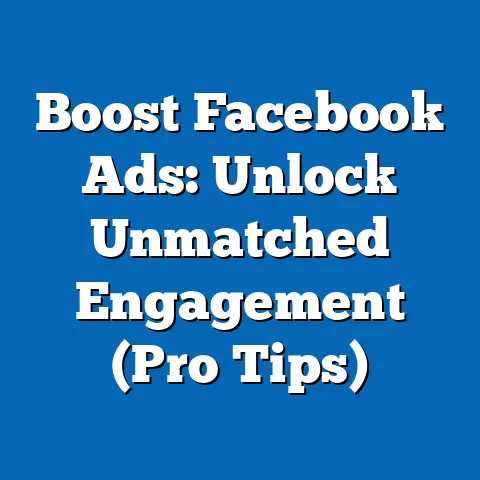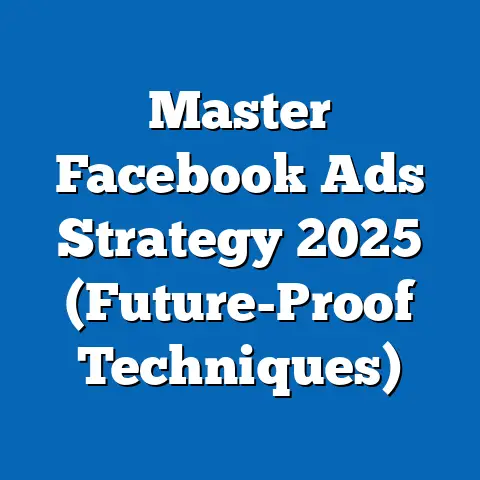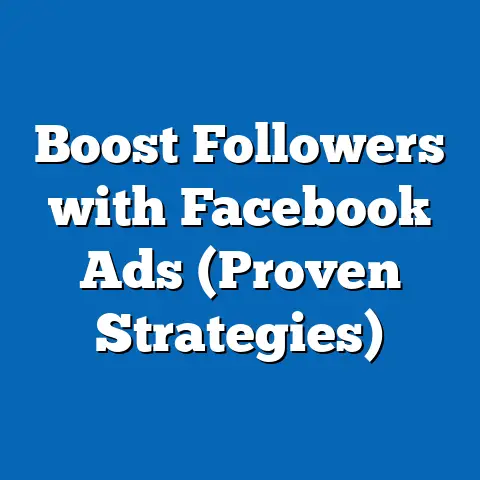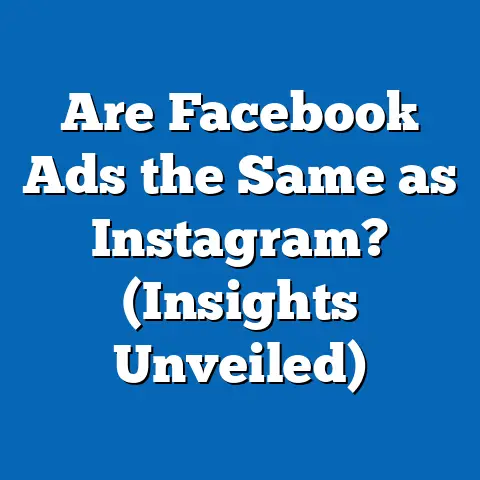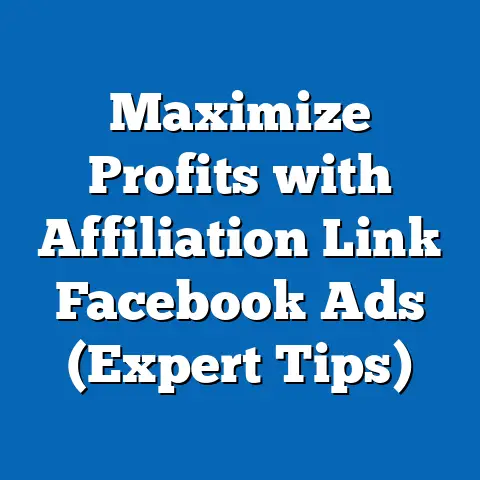Reduce Facebook Ad Frequency (Pro Tips for Higher ROI)
Have you ever felt like you’re shouting into a void? I know I have. I remember working with a local bookstore that was so excited to launch their first Facebook ad campaign. They envisioned lines out the door, a bustling community event every weekend, and a revival of the written word in their town. They poured their limited marketing budget into Facebook ads, eager to share their passion for books with the world.
But what happened? Initially, there was a spark. A few new faces, some online orders, and a sense of accomplishment. But as weeks turned into months, the excitement waned. The same ads, showcasing the same books, appeared repeatedly in people’s feeds. Engagement plummeted. The bookstore owner, let’s call her Emily, started to feel deflated. She was pouring money into Facebook, but the return was shrinking with each passing day.
I remember sitting with Emily, the weight of her disappointment palpable. She’d invested not just her money, but her hopes and dreams into this campaign. The ads that were supposed to breathe new life into her business were now just a source of frustration. It was then I realized the crucial role of ad frequency. It wasn’t just about getting the message out there; it was about getting it out there the right way.
This article is for Emily, and for every small business owner, marketer, and entrepreneur who’s felt the sting of diminishing returns on their Facebook ad spend. I’m going to dive deep into the world of ad frequency, explaining why it matters, how it can hurt your ROI, and, most importantly, how you can reduce it to achieve better results.
Section 1: Understanding Ad Frequency
At its core, ad frequency is the average number of times a single person sees your ad. It’s a simple concept, but its implications are far-reaching. On Facebook, ad frequency is a key metric that dictates how your audience perceives your brand and, ultimately, how effective your campaigns are.
Why is it so important? Because it’s the tightrope walk between brand awareness and annoyance. One the one hand, you need to expose your audience to your message enough times for it to register. On the other hand, overexposure leads to ad fatigue, a phenomenon where your audience becomes desensitized to your ads, or worse, develops a negative association with your brand.
To understand ad frequency, we need to grasp the metrics behind it:
- Impressions: The total number of times your ad is displayed, regardless of whether it’s seen by the same person multiple times.
- Reach: The total number of unique individuals who have seen your ad.
Ad frequency is calculated by dividing the total number of impressions by the reach. For example, if your ad has 10,000 impressions and reached 2,000 people, your ad frequency is 5. This means, on average, each person saw your ad five times.
Now, let’s talk about the psychological effects. Imagine seeing the same commercial over and over during your favorite TV show. At first, you might pay attention, but after the tenth time, you’re likely to tune it out or even feel irritated. The same principle applies to Facebook ads.
Ad fatigue sets in when users are repeatedly exposed to the same ad, leading to:
- Decreased engagement: Fewer clicks, likes, and shares.
- Negative sentiment: Users hiding or reporting your ad.
- Brand devaluation: A perception that your brand is intrusive or annoying.
I’ve seen this firsthand. One time, I was consulting for a local gym. They were running a promotion for a free trial, and their ads were everywhere. People in the community were complaining about seeing the same ad multiple times a day. The gym saw a spike in negative comments and a drop in sign-ups, proving that too much exposure can backfire.
Data backs this up. Studies have shown a clear correlation between high ad frequency and declining click-through rates (CTR). For instance, a study by Nielsen found that ad recall and brand lift peaked at a certain frequency level, after which they started to decline. This suggests that there’s a sweet spot for ad exposure, beyond which the benefits diminish.
Key Takeaway: Ad frequency is a critical metric that measures how often your target audience sees your ad. Understanding the psychological effects of ad fatigue and the impact of high frequency on engagement and brand perception is crucial for optimizing your Facebook ad campaigns.
Section 2: The Cost of High Frequency
The consequences of high ad frequency extend far beyond annoyed customers. It directly impacts your bottom line, leading to wasted ad spend and diminishing returns. I’ve seen businesses unknowingly pour money into campaigns that were actively alienating their target audience. It’s a frustrating situation, but one that can be avoided with a better understanding of the true cost of high frequency.
One of the most obvious costs is wasted ad spend. When your audience is seeing your ad too often, they’re less likely to engage with it. This means you’re paying for impressions that aren’t generating any value. You’re essentially throwing money away on an audience that’s already tuned out.
But the costs don’t stop there. High ad frequency can also lead to diminishing returns. As your audience becomes more familiar with your ad, its effectiveness decreases. The initial novelty wears off, and users become desensitized to your message. This results in lower click-through rates, fewer conversions, and a reduced return on investment (ROI).
I recall a case study from a local e-commerce business that sold handmade jewelry. They ran a Facebook ad campaign promoting their latest collection. Initially, the campaign performed well, with a decent CTR and a positive ROI. However, as the campaign continued, the ad frequency increased, and the CTR began to plummet. The business owner, Sarah, was perplexed. She was spending the same amount of money, but the results were significantly worse.
Upon closer examination, it became clear that the high ad frequency was to blame. The audience was seeing the same ads repeatedly, and they were simply tuning them out. The jewelry, no matter how beautiful, lost its appeal after being seen countless times. Sarah was essentially paying for impressions that were generating zero revenue.
To make matters worse, high ad frequency can also damage your brand reputation. Overexposure can create a negative perception of your brand, making it seem intrusive or annoying. Users may start to associate your brand with unwanted advertising, leading to a decline in brand loyalty and customer satisfaction.
I’ve heard countless stories from marketers and business owners who have faced similar challenges. They describe the emotional toll of seeing their hard-earned money go to waste and the frustration of not knowing how to fix the problem. It’s a disheartening experience that can leave you feeling helpless and overwhelmed.
One marketer I spoke with, David, shared his experience of running a campaign for a local restaurant. He initially saw great results, but as the ad frequency increased, he noticed a surge in negative comments on his ads. People were complaining about seeing the same ad over and over, and they were starting to associate the restaurant with spammy advertising.
David told me, “It was heartbreaking to see my efforts backfire like that. I was trying to promote a great restaurant, but instead, I was annoying people and damaging their perception of the brand.”
Maintaining a healthy balance in ad frequency is crucial for fostering positive brand perception and achieving a positive ROI. It’s about finding the sweet spot where your ads are seen enough times to be effective, but not so often that they become annoying.
Key Takeaway: High ad frequency can lead to wasted ad spend, diminishing returns, and damage to your brand reputation. Maintaining a healthy balance in ad frequency is crucial for fostering positive brand perception and achieving a positive ROI.
Section 3: Pro Tips for Reducing Facebook Ad Frequency
Now that we understand the importance of managing ad frequency, let’s dive into some actionable tips for reducing it on Facebook. These strategies are designed to help you reach your target audience effectively without overwhelming them with repetitive ads.
Tip 1: Audience Segmentation
One of the most effective ways to reduce ad frequency is through audience segmentation. This involves dividing your target audience into smaller, more specific groups based on their interests, demographics, behaviors, and other relevant characteristics.
By segmenting your audience, you can ensure that your ads are delivered to the right people at the right time, reducing the likelihood of overexposure. For example, you might segment your audience based on their purchase history, website activity, or engagement with your previous ads.
Here’s how you can segment your audience effectively:
- Demographics: Target users based on age, gender, location, education, and other demographic factors. This is a basic but essential segmentation strategy.
- Interests: Target users based on their interests and hobbies. Facebook allows you to target users based on their expressed interests, pages they’ve liked, and groups they’ve joined.
- Behaviors: Target users based on their online behavior, such as their purchase history, website activity, and mobile device usage.
- Custom Audiences: Create custom audiences based on your existing customer data, such as email lists, website visitors, and app users. This allows you to target users who are already familiar with your brand.
- Lookalike Audiences: Expand your reach by creating lookalike audiences based on your custom audiences. Facebook will identify users who share similar characteristics with your existing customers.
I remember working with a clothing retailer that was struggling with high ad frequency. They were targeting a broad audience with generic ads, resulting in overexposure and declining engagement. By segmenting their audience based on their purchase history and website activity, they were able to deliver more relevant ads to specific groups of users. This reduced their ad frequency and improved their overall ROI.
Tip 2: Creative Variations
Another effective way to combat ad fatigue is by creating multiple ad variations. This involves producing different versions of your ads with varying visuals, messaging, and formats. By rotating these variations, you can keep your content fresh and engaging, preventing your audience from becoming desensitized.
Here are some strategies for creating creative variations:
- Visuals: Use different images, videos, and graphics to showcase your product or service. Experiment with different styles, colors, and compositions.
- Messaging: Vary your ad copy, headlines, and calls to action. Test different tones, angles, and value propositions.
- Formats: Use different ad formats, such as single image ads, video ads, carousel ads, and collection ads. Each format offers a unique way to engage your audience.
- Angles: Try different angles to appeal to different segments of your audience. Some might respond better to humor, while others might prefer a more serious approach.
I once consulted for a local restaurant that was promoting a new menu item. They initially ran a single image ad with a generic description. However, they quickly realized that their ad frequency was too high, and their engagement was declining.
To address this, I suggested creating multiple ad variations with different visuals, messaging, and formats. We produced a video ad showcasing the chef preparing the dish, a carousel ad highlighting the ingredients, and a single image ad with a customer testimonial. By rotating these variations, we were able to keep the content fresh and engaging, reducing ad frequency and improving overall campaign performance.
Tip 3: Frequency Capping
Frequency capping is a feature within Facebook Ads Manager that allows you to limit the number of times a user sees your ad within a specific time period. This is a crucial tool for maintaining engagement and preventing ad fatigue.
By setting a frequency cap, you can ensure that your ads are seen enough times to be effective, but not so often that they become annoying. The optimal frequency cap will vary depending on your target audience, ad creative, and campaign goals.
Here’s how to set a frequency cap in Facebook Ads Manager:
- Go to your ad set settings.
- Scroll down to the “Optimization & Delivery” section.
- Click on “Show Advanced Options.”
- Under “Frequency Capping,” set the maximum number of impressions per person per day or week.
I recommend starting with a conservative frequency cap and gradually increasing it as needed. Monitor your ad performance closely to determine the optimal frequency for your specific audience.
Tip 4: Retargeting Strategies
Retargeting is a powerful advertising technique that allows you to reach users who have previously interacted with your brand, such as website visitors, app users, or customers who have abandoned their shopping carts.
Retargeting can be highly effective because you’re targeting users who are already familiar with your brand and have expressed interest in your products or services. However, it’s important to implement retargeting strategies carefully to avoid overwhelming your audience with repetitive ads.
Here are some tips for effective retargeting:
- Segmentation: Segment your retargeting audience based on their level of engagement. For example, you might target users who have abandoned their shopping carts with a special offer, while targeting users who have visited your website with a more general ad.
- Frequency Capping: Set a frequency cap for your retargeting ads to prevent overexposure.
- Dynamic Ads: Use dynamic ads to show users the specific products they viewed on your website. This is a highly personalized and effective retargeting strategy.
- Exclusion Audiences: Exclude users who have already converted from your retargeting campaigns. This prevents you from wasting ad spend on users who have already made a purchase.
I once worked with an e-commerce business that was struggling to convert website visitors into customers. They were running a generic retargeting campaign that targeted all website visitors with the same ad. This resulted in high ad frequency and low conversion rates.
To address this, I suggested segmenting their retargeting audience based on their website activity. We created separate campaigns for users who had abandoned their shopping carts, users who had viewed specific products, and users who had simply visited the homepage. We then tailored the ads to each segment, offering personalized incentives and messaging. This resulted in a significant increase in conversion rates and a reduction in ad frequency.
Tip 5: A/B Testing
A/B testing is a powerful method for determining the optimal ad frequency for your specific audience. By running A/B tests, you can compare the performance of different ad frequencies and identify the sweet spot where your ads are most effective.
Here’s how to conduct A/B tests for ad frequency:
- Create two identical ad sets with the same targeting options and ad creative.
- Set different frequency caps for each ad set. For example, you might set a frequency cap of 2 impressions per day for one ad set and 4 impressions per day for the other.
- Monitor the performance of each ad set closely, paying attention to metrics such as CTR, conversion rates, and ROI.
- Analyze the results and determine which ad set performed better.
- Adjust your frequency caps accordingly.
I recommend running A/B tests continuously to stay on top of changes in your audience behavior and ad performance. The optimal ad frequency may vary over time, so it’s important to stay flexible and adapt your campaigns accordingly.
Tip 6: Monitoring and Analytics
Ongoing monitoring of your ad performance metrics is crucial for making informed decisions about ad frequency adjustments. By tracking key metrics such as impressions, reach, frequency, CTR, and conversion rates, you can identify potential issues and optimize your campaigns for maximum effectiveness.
Here are some key metrics to monitor:
- Frequency: The average number of times a user sees your ad.
- Reach: The total number of unique individuals who have seen your ad.
- CTR: The percentage of users who click on your ad.
- Conversion Rate: The percentage of users who complete a desired action, such as making a purchase or filling out a form.
- Cost Per Click (CPC): The average cost you pay for each click on your ad.
- Cost Per Conversion (CPC): The average cost you pay for each conversion.
- Return on Ad Spend (ROAS): The amount of revenue you generate for every dollar you spend on advertising.
I recommend setting up a dashboard to track these metrics in real-time. This will allow you to quickly identify any issues and make necessary adjustments to your campaigns.
Key Takeaway: Reducing Facebook ad frequency involves implementing a combination of strategies, including audience segmentation, creative variations, frequency capping, retargeting strategies, A/B testing, and ongoing monitoring of ad performance metrics. By implementing these tips, you can ensure that your ads are seen enough times to be effective, but not so often that they become annoying.
Section 4: Case Studies and Success Stories
Let’s move from theory to practice. I want to share some real-life examples of businesses that successfully reduced their Facebook ad frequency and saw significant improvements in their ROI. These case studies highlight the transformative power of effective ad frequency management.
Case Study 1: Local Coffee Shop
A local coffee shop was running a Facebook ad campaign to promote their new seasonal menu. They were targeting a broad audience with a single ad, resulting in high ad frequency and declining engagement.
To address this, they implemented the following strategies:
- Audience Segmentation: They segmented their audience based on their interests and demographics.
- Creative Variations: They created multiple ad variations with different visuals and messaging.
- Frequency Capping: They set a frequency cap of 3 impressions per day.
As a result, they saw a significant reduction in ad frequency and a corresponding increase in engagement and sales. The owner reported a 20% increase in revenue and a noticeable improvement in customer sentiment.
Case Study 2: Online Clothing Retailer
An online clothing retailer was struggling with high ad frequency and low conversion rates. They were retargeting all website visitors with the same ad, resulting in overexposure and ad fatigue.
To address this, they implemented the following strategies:
- Retargeting Segmentation: They segmented their retargeting audience based on their website activity.
- Dynamic Ads: They used dynamic ads to show users the specific products they viewed on their website.
- Exclusion Audiences: They excluded users who had already converted from their retargeting campaigns.
As a result, they saw a dramatic improvement in conversion rates and a reduction in ad frequency. The marketing manager reported a 30% increase in revenue and a significant improvement in ROI.
Case Study 3: Fitness Studio
A fitness studio was running a Facebook ad campaign to promote their new membership packages. They were targeting a broad audience with a generic ad, resulting in high ad frequency and negative sentiment.
To address this, they implemented the following strategies:
- Audience Segmentation: They segmented their audience based on their fitness interests and demographics.
- Creative Variations: They created multiple ad variations with different visuals and messaging.
- A/B Testing: They ran A/B tests to determine the optimal ad frequency for their specific audience.
As a result, they saw a significant reduction in ad frequency and a corresponding increase in positive sentiment and membership sign-ups. The owner reported a 25% increase in new members and a noticeable improvement in brand perception.
These case studies demonstrate that managing ad frequency is not just about avoiding annoyance; it’s about optimizing your campaigns for maximum effectiveness. By implementing the strategies discussed in this article, you can achieve better results and a higher ROI.
I remember speaking with the owner of the coffee shop after they implemented these changes. She told me, “It was like a breath of fresh air. We were finally reaching the right people with the right message, and it was making a real difference in our business.”
Key Takeaway: Real-life case studies demonstrate that reducing Facebook ad frequency can lead to significant improvements in ROI, engagement, and brand perception. By implementing the strategies discussed in this article, businesses can achieve better results and a higher return on their advertising investment.
Conclusion
Let’s return to Emily, the owner of the struggling bookstore from the beginning of our journey. After implementing the pro tips and strategies we’ve explored, she was able to breathe new life into her Facebook ad campaign.
She started by segmenting her audience, targeting book lovers based on their specific interests and reading habits. She created multiple ad variations, showcasing different genres, authors, and events. She set a frequency cap to ensure that her ads weren’t overwhelming her audience.
The results were remarkable. Emily saw a significant reduction in ad frequency and a corresponding increase in engagement. People started clicking on her ads, visiting her website, and attending her events. Her sales increased, and her business began to thrive once again.
I remember the day Emily called me to share her success. Her voice was filled with emotion. She told me, “I can’t thank you enough. You helped me save my business.”
Emily’s story is a testament to the transformative power of effective ad frequency management. By understanding and managing ad frequency, you can achieve higher ROI, improve brand perception, and ultimately, achieve your business goals.
The world of Facebook advertising is constantly evolving, but one thing remains constant: the importance of understanding and managing ad frequency. By implementing the pro tips and strategies discussed in this article, you can ensure that your ads are seen enough times to be effective, but not so often that they become annoying.
Remember, it’s not just about getting your message out there; it’s about getting it out there the right way. And by mastering the art of ad frequency management, you can unlock the full potential of Facebook advertising and achieve lasting success.

